Abstract
A prospective longitudinal survey of cutaneous leishmaniasis (Leishmania peruviana) was carried out in Peru on a study population of 4716 persons living in 38 villages (Departments of Lima, Ancash and Piura). Demographic and clinical data were collected from all individuals, and a Montenegro skin test (MST) was carried out on 72% (3418) of the study population. Each household was revisited at 3-monthly intervals for up to 2 years to detect new leishmaniasis cases; 497 people received a second MST at the end of the study. Analysis of the epidemiological data indicated that (i) 17% (16/94) of all infections were subclinical, (ii) this percentage increased significantly with age, (iii) clinical infections led to 73.9% protective immunity (95% C.I. 53.0-85.5%) and relatively permanent MST responsiveness (recovery rate = 0.0098/year; 95% C.I. 0.000-0.020/year), (iv) sub-clinical infections led to protective immunity, which was positively correlated with their MST induration size (increasing by 17.9% per mm; P < 0.0001), and a mean MST recovery rate of 0.114/year (4/421 man-months), and (v) recurrent leishmaniasis was dominated by reactivations, not by reinfections.
Full text
PDF

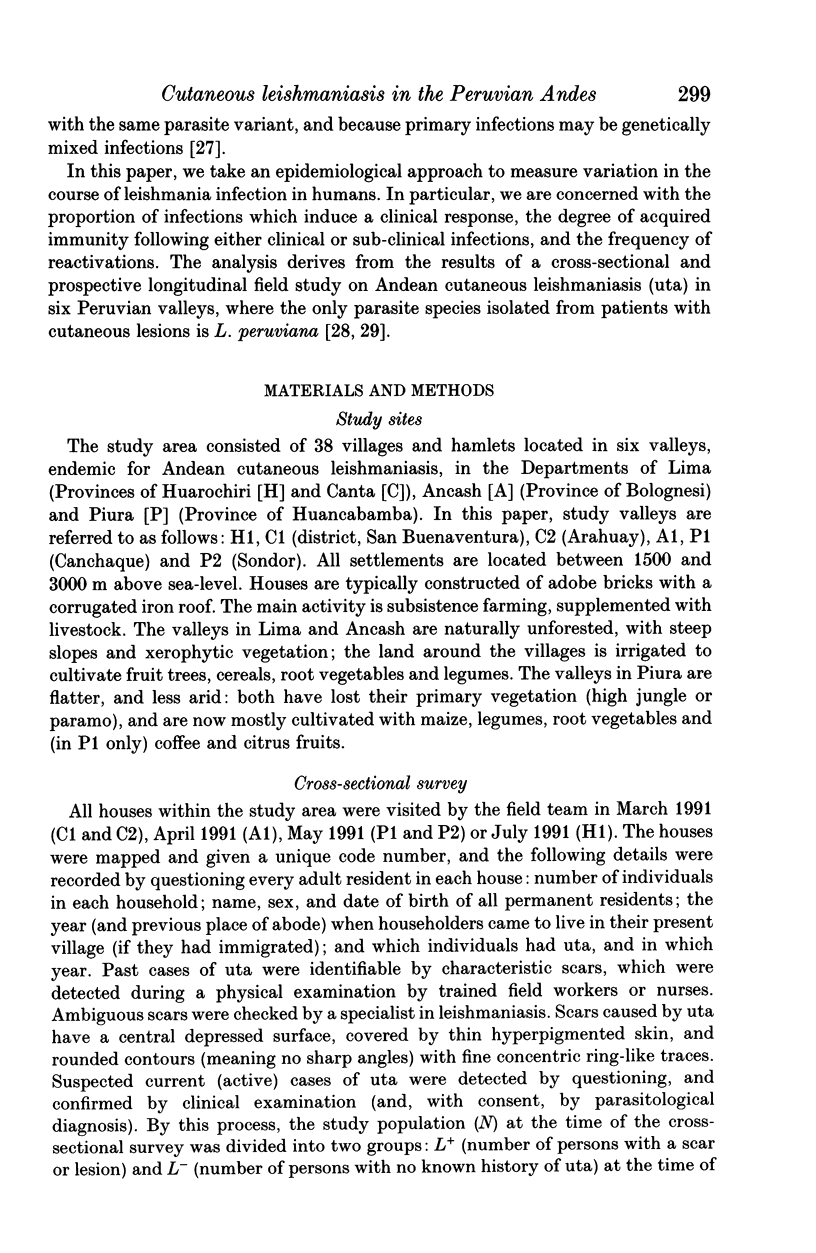





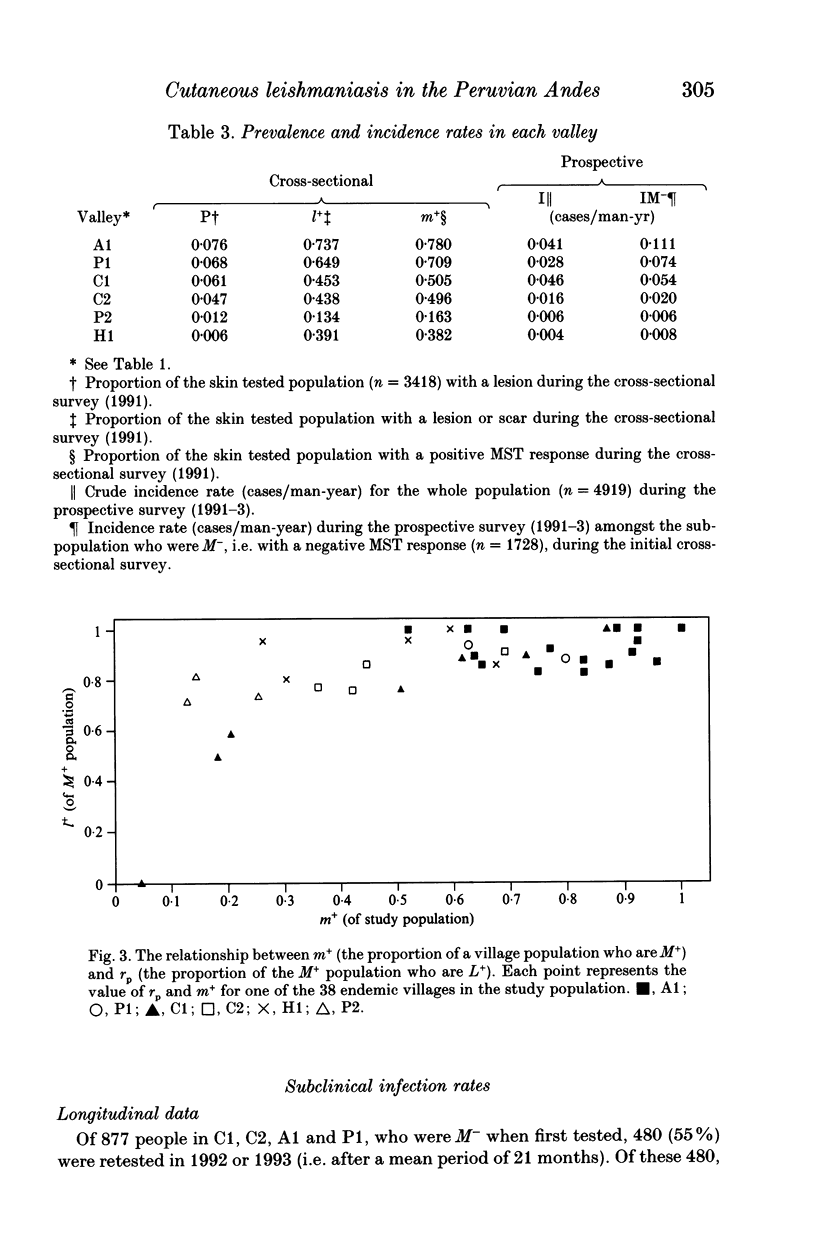

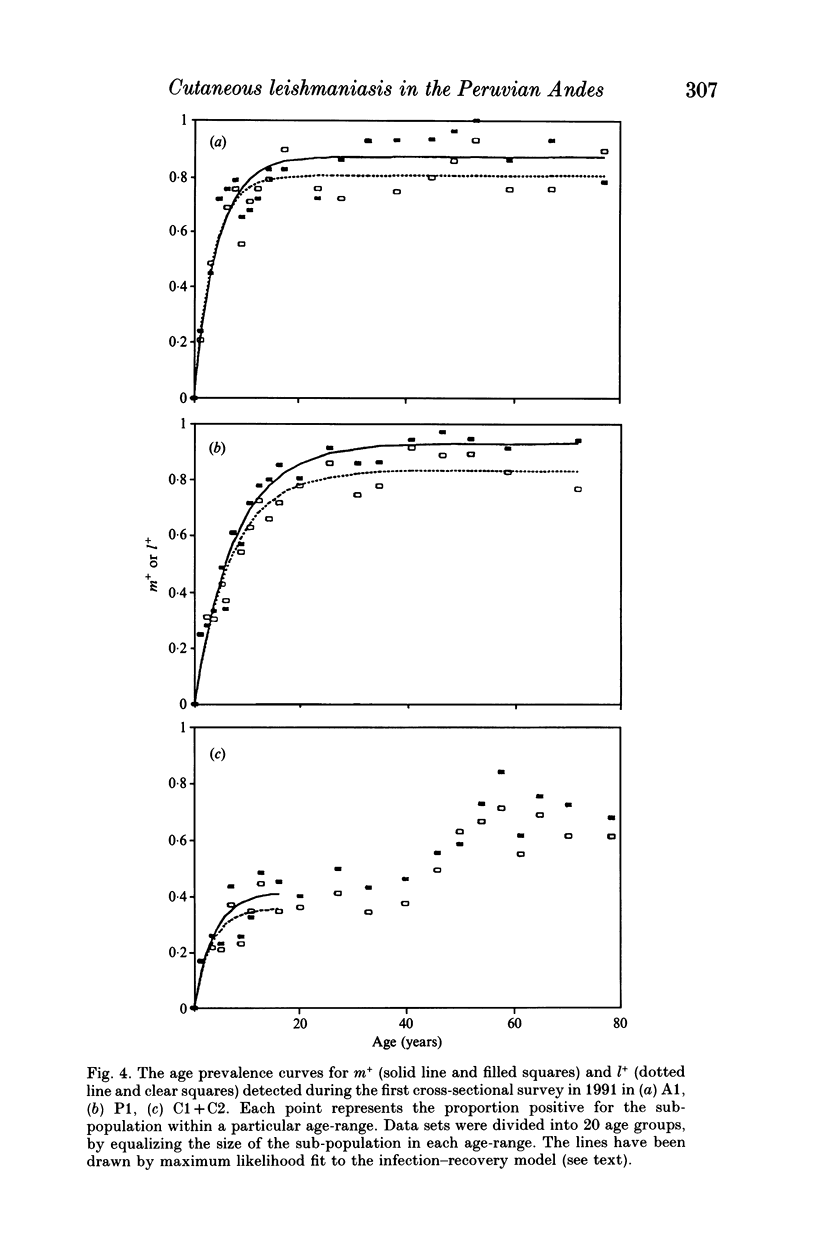
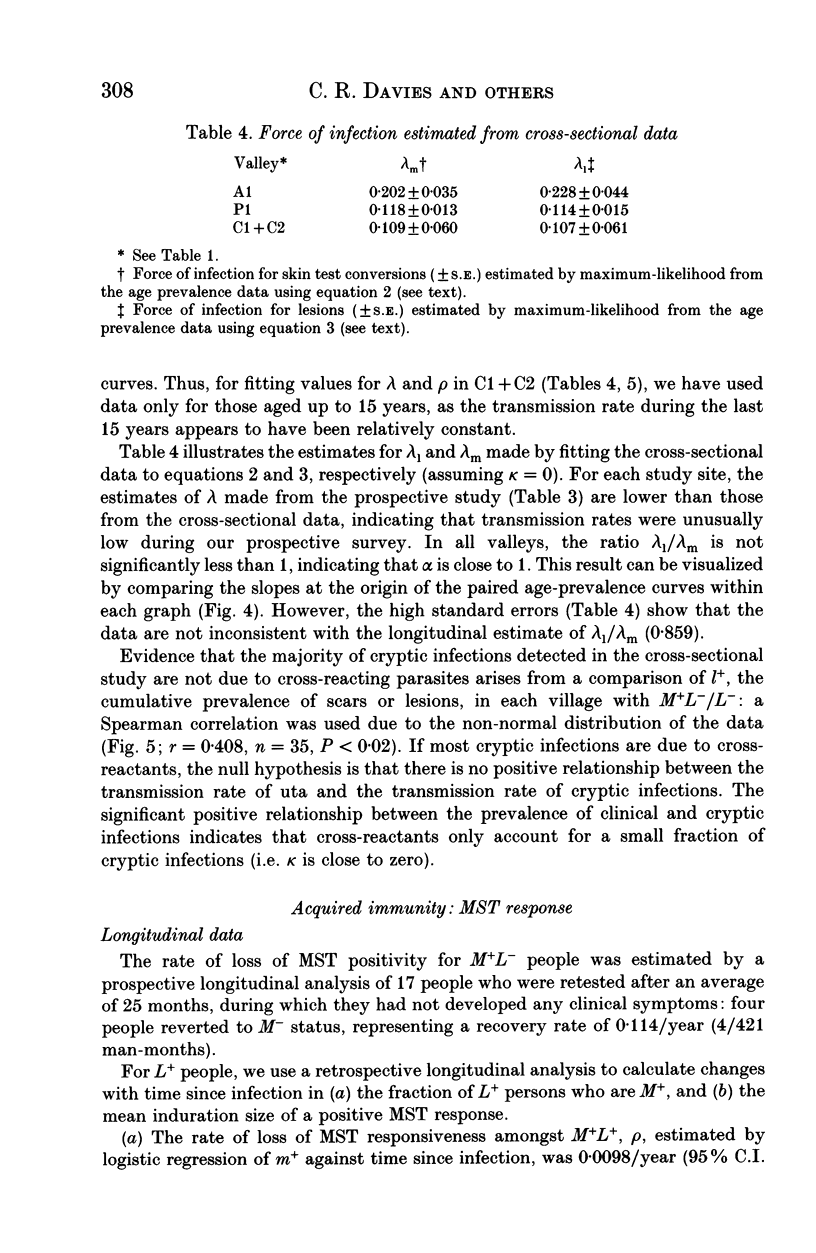
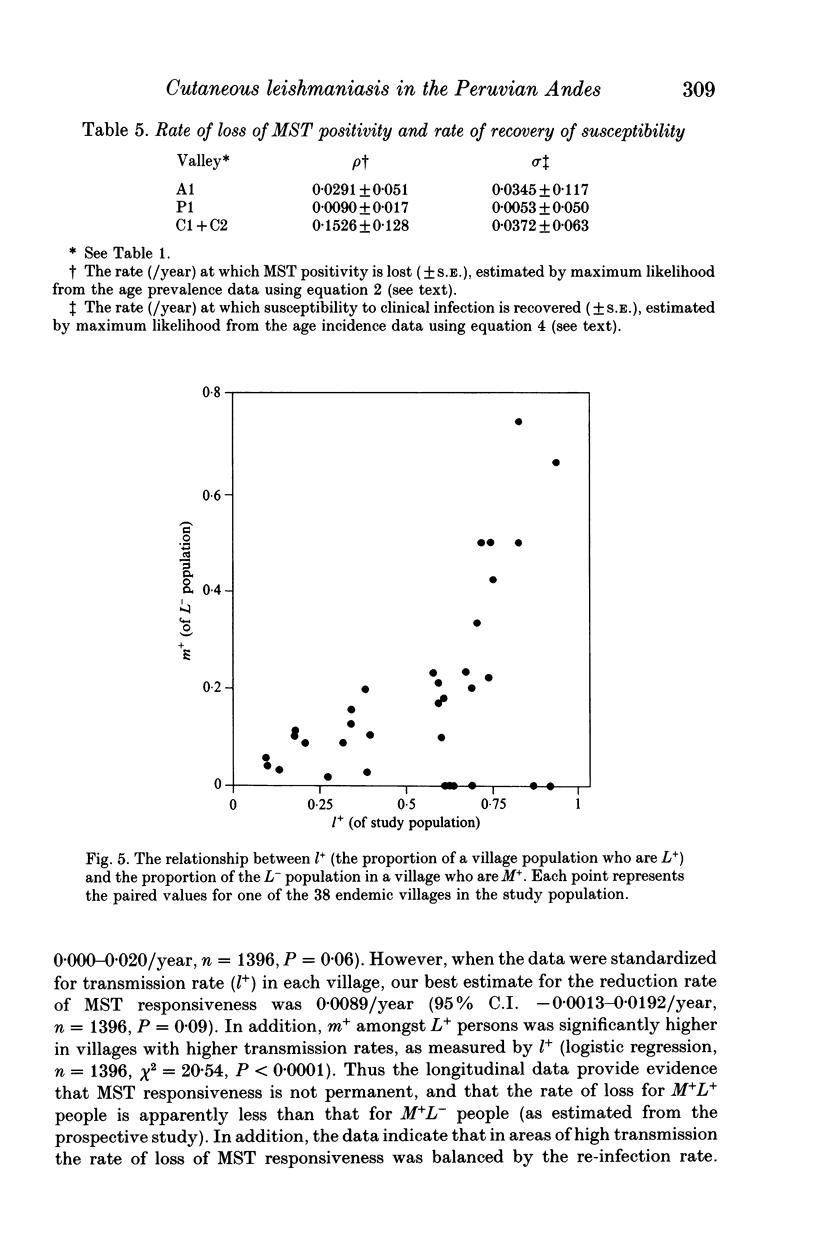


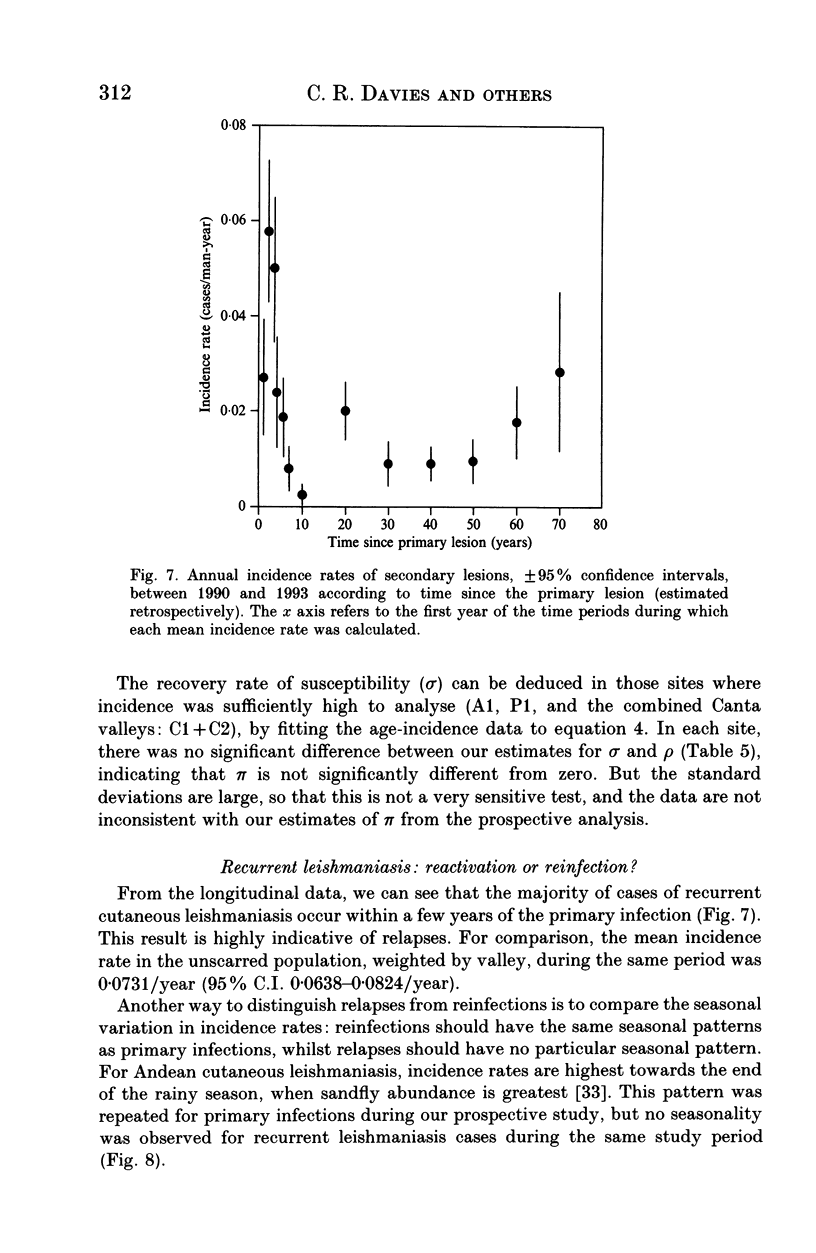
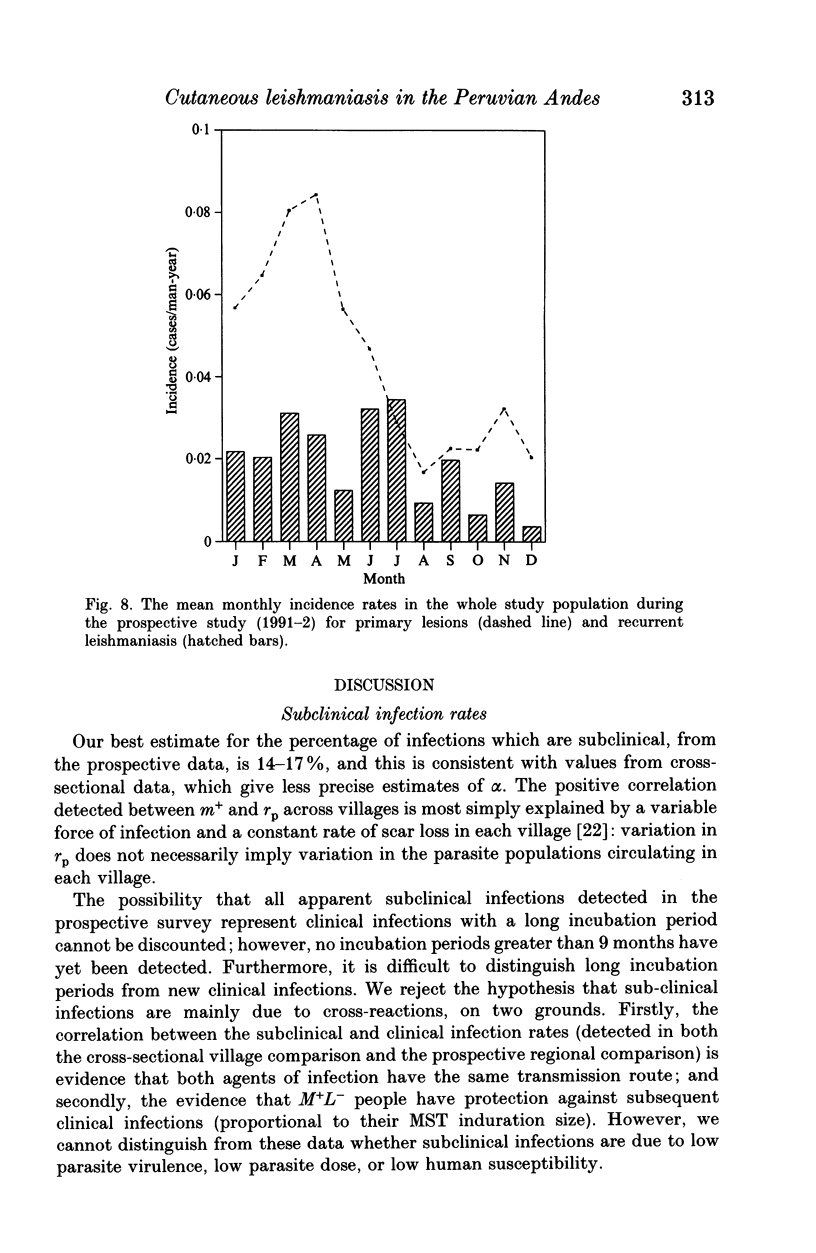





Selected References
These references are in PubMed. This may not be the complete list of references from this article.
- Aebischer T. Recurrent cutaneous leishmaniasis: a role for persistent parasites? Parasitol Today. 1994 Jan;10(1):25–28. doi: 10.1016/0169-4758(94)90353-0. [DOI] [PubMed] [Google Scholar]
- Ayesta C., Argüello C., Hernández A. G. Leishmania braziliensis: cell surface differences in promastigotes of pathogenic and nonpathogenic strains. Exp Parasitol. 1985 Apr;59(2):185–191. doi: 10.1016/0014-4894(85)90071-2. [DOI] [PubMed] [Google Scholar]
- Barretto A. C., Cuba C. A., Marsden P. D., Vexanat J. A., De Belder M. Características epidemiológicas da leishmaniose tegumentar americana em uma região endêmica do estado da Bahia, Brasil. I. Leishmaniose humana. Bol Oficina Sanit Panam. 1981 May;90(5):415–424. [PubMed] [Google Scholar]
- Cerf B. J., Jones T. C., Badaro R., Sampaio D., Teixeira R., Johnson W. D., Jr Malnutrition as a risk factor for severe visceral leishmaniasis. J Infect Dis. 1987 Dec;156(6):1030–1033. doi: 10.1093/infdis/156.6.1030. [DOI] [PubMed] [Google Scholar]
- Chang K. P., Chaudhuri G., Fong D. Molecular determinants of Leishmania virulence. Annu Rev Microbiol. 1990;44:499–529. doi: 10.1146/annurev.mi.44.100190.002435. [DOI] [PubMed] [Google Scholar]
- Conceiço-Silva F., Dórea R. C., Pirmez C., Schubach A., Coutinho S. G. Quantitative study of Leishmania braziliensis braziliensis reactive T cells in peripheral blood and in the lesions of patients with American mucocutaneous leishmaniasis. Clin Exp Immunol. 1990 Feb;79(2):221–226. doi: 10.1111/j.1365-2249.1990.tb05182.x. [DOI] [PMC free article] [PubMed] [Google Scholar]
- Cuba-Cuba C. A., Evans D., Rosa A. de C., Marsden P. D. Clonal variation within a mucosal isolate derived from a patient with Leishmania (Viannia) braziliensis infection. Rev Inst Med Trop Sao Paulo. 1991 Sep-Oct;33(5):343–350. doi: 10.1590/s0036-46651991000500002. [DOI] [PubMed] [Google Scholar]
- Davies C. R., Fernandez M., Paz L., Roncal N., Llanos-Cuentas A. Lutzomyia verrucarum can transmit Leishmania peruviana, the aetiological agent of Andean cutaneous leishmaniasis. Trans R Soc Trop Med Hyg. 1993 Sep-Oct;87(5):603–606. doi: 10.1016/0035-9203(93)90103-w. [DOI] [PubMed] [Google Scholar]
- Davies C. R., Llanos-Cuentas A., Canales J., Leon E., Alvarez E., Monge J., Tolentino E., Gomero Q., Pyke S., Dye C. The fall and rise of Andean cutaneous leishmaniasis: transient impact of the DDT campaign in Peru. Trans R Soc Trop Med Hyg. 1994 Jul-Aug;88(4):389–393. doi: 10.1016/0035-9203(94)90395-6. [DOI] [PubMed] [Google Scholar]
- Dujardin J. C., Llanos-Cuentas A., Caceres A., Arana M., Dujardin J. P., Guerrini F., Gomez J., Arroyo J., De Doncker S., Jacquet D. Molecular karyotype variation in Leishmania (Viannia) peruviana: indication of geographical populations in Peru distributed along a north-south cline. Ann Trop Med Parasitol. 1993 Aug;87(4):335–347. doi: 10.1080/00034983.1993.11812777. [DOI] [PubMed] [Google Scholar]
- Dye C. Leishmaniasis epidemiology: the theory catches up. Parasitology. 1992;104 (Suppl):S7–18. doi: 10.1017/s0031182000075211. [DOI] [PubMed] [Google Scholar]
- Greenblatt C. L., Handman E., Mitchell G. F., Battye F. L., Schnur L. F., Snary D. Phenotypic diversity of cloned lines of Leishmania major promastigotes. Z Parasitenkd. 1985;71(2):141–157. doi: 10.1007/BF00926265. [DOI] [PubMed] [Google Scholar]
- Guevara P., Ramírez J. L., Rojas E., Scorza J. V., González N., Añez N. Leishmania braziliensis in blood 30 years after cure. Lancet. 1993 May 22;341(8856):1341–1341. doi: 10.1016/0140-6736(93)90845-8. [DOI] [PubMed] [Google Scholar]
- Gutierrez Y., Salinas G. H., Palma G., Valderrama L. B., Santrich C. V., Saravia N. G. Correlation between histopathology, immune response, clinical presentation, and evolution in Leishmania braziliensis infection. Am J Trop Med Hyg. 1991 Sep;45(3):281–289. doi: 10.4269/ajtmh.1991.45.281. [DOI] [PubMed] [Google Scholar]
- Hashiguchi Y., Arias O., Maciel D., Mansur J., Furuya M., Kawabata M. Cutaneous leishmaniasis in south-eastern Paraguay: a study of an endemic area at Limoy. Trans R Soc Trop Med Hyg. 1991 Sep-Oct;85(5):592–594. doi: 10.1016/0035-9203(91)90355-3. [DOI] [PubMed] [Google Scholar]
- Jones T. C., Johnson W. D., Jr, Barretto A. C., Lago E., Badaro R., Cerf B., Reed S. G., Netto E. M., Tada M. S., Franca T. F. Epidemiology of American cutaneous leishmaniasis due to Leishmania braziliensis braziliensis. J Infect Dis. 1987 Jul;156(1):73–83. doi: 10.1093/infdis/156.1.73. [DOI] [PubMed] [Google Scholar]
- Kahl L. P., Byram J. E., David J. R. Leishmania (Viannia) braziliensis isolated from cutaneous and mucosal lesions of patients residing in Tres Bracos, Bahia, Brazil differ in virulence for the golden hamster. Trans R Soc Trop Med Hyg. 1990 Nov-Dec;84(6):783–784. doi: 10.1016/0035-9203(90)90078-s. [DOI] [PubMed] [Google Scholar]
- Lara M. L., Layrisse Z., Scorza J. V., Garcia E., Stoikow Z., Granados J., Bias W. Immunogenetics of human American cutaneous leishmaniasis. Study of HLA haplotypes in 24 families from Venezuela. Hum Immunol. 1991 Feb;30(2):129–135. doi: 10.1016/0198-8859(91)90081-j. [DOI] [PubMed] [Google Scholar]
- Marrano N. N., Mata L. J., Durack D. T. Cutaneous leishmaniasis in rural Costa Rica. Trans R Soc Trop Med Hyg. 1989 May-Jun;83(3):340–340. doi: 10.1016/0035-9203(89)90496-3. [DOI] [PubMed] [Google Scholar]
- Marzochi M. C., Coutinho S. G., Sabroza P. C., de Souza W. J. Reaço de imunofluorescência indireta e intradermorreaço para leishmaniose tegumentar americana em moradores na área de Jacarepaguá (Rio de Janeiro). Estudo comparativo dos resultados observados em 1974 e 1978. Rev Inst Med Trop Sao Paulo. 1980 May-Jun;22(3):149–155. [PubMed] [Google Scholar]
- Mayrink W., Melo M. N., da Costa C. A., Magalhães P. A., Dias M., Coelho M. V., Araujo F. G., Williams P., Figueiredo Y. P., Batista S. M. Intradermorreaço de Montenegro na leishmaniose tegumentar americana após terapêutica antimonial. Rev Inst Med Trop Sao Paulo. 1976 May-Jun;18(3):182–185. [PubMed] [Google Scholar]
- Nascimento M. D., Alcântara-Neves N. M., Muniz M. E., Nunes S. F., Paranhos M., de Carvalho L. C. Induction and modulation of the immune response to Leishmania by Montenegro's skin test. Trans R Soc Trop Med Hyg. 1993 Jan-Feb;87(1):91–93. doi: 10.1016/0035-9203(93)90439-w. [DOI] [PubMed] [Google Scholar]
- Oliveira-Neto M. P., Pirmez C., Rangel E., Schubach A., Grimaldi Júnior G. An outbreak of American cutaneous leishmaniasis (Leishmania braziliensis braziliensis) in a periurban area of Rio de Janeiro city, Brazil: clinical and epidemiological studies. Mem Inst Oswaldo Cruz. 1988 Oct-Dec;83(4):427–435. doi: 10.1590/s0074-02761988000400006. [DOI] [PubMed] [Google Scholar]
- PESSOA S. B., LOPES J. A. S OBRE A INTRADERMORREA C AO DE MONTENEGRO EM REGI AO END EMICA DE LEISHMANIOSE TEGUMENTAR E VISCERAL. Rev Inst Med Trop Sao Paulo. 1963 Jul-Aug;5:170–175. [PubMed] [Google Scholar]
- Passos V. M., Falcão A. L., Marzochi M. C., Gontijo C. M., Dias E. S., Barbosa-Santos E. G., Guerra H. L., Katz N. Epidemiological aspects of American cutaneous leishmaniasis in a periurban area of the metropolitan region of Belo Horizonte, Minas Gerais, Brazil. Mem Inst Oswaldo Cruz. 1993 Jan-Mar;88(1):103–110. doi: 10.1590/s0074-02761993000100016. [DOI] [PubMed] [Google Scholar]
- Perez J. E., Villaseca P., Caceres A., Lopez M., Zolessi A., Campos M., Guerra H., Llanos-Cuentas A. Leishmania (Viannia) peruviana isolated from the sandfly Lutzomyia peruensis (Diptera: Psychodidae) and a sentinel hamster in the Huayllacallán Valley, Ancash, Peru. Trans R Soc Trop Med Hyg. 1991 Jan-Feb;85(1):60–60. doi: 10.1016/0035-9203(91)90158-u. [DOI] [PubMed] [Google Scholar]
- Petzl-Erler M. L., Belich M. P., Queiroz-Telles F. Association of mucosal leishmaniasis with HLA. Hum Immunol. 1991 Dec;32(4):254–260. doi: 10.1016/0198-8859(91)90088-q. [DOI] [PubMed] [Google Scholar]
- Saravia N. G., Valderrama L., Labrada M., Holguín A. F., Navas C., Palma G., Weigle K. A. The relationship of Leishmania braziliensis subspecies and immune response to disease expression in New World leishmaniasis. J Infect Dis. 1989 Apr;159(4):725–735. doi: 10.1093/infdis/159.4.725. [DOI] [PubMed] [Google Scholar]
- Saravia N. G., Weigle K., Segura I., Giannini S. H., Pacheco R., Labrada L. A., Goncalves A. Recurrent lesions in human Leishmania braziliensis infection--reactivation or reinfection? Lancet. 1990 Aug 18;336(8712):398–402. doi: 10.1016/0140-6736(90)91945-7. [DOI] [PubMed] [Google Scholar]
- Scorza J. V., Valera M., Moreno E., Jaimes R. Encuesta epidemiológica sobre leishmaniasis cutanea. Un estudio en Mérida, Venezuela. Bol Oficina Sanit Panam. 1983 Aug;95(2):118–133. [PubMed] [Google Scholar]
- Seyedi-Rashti M. A., Nadim A. Re-establishment of cutaneous leishmaniasis after cessation of anti-malaria spraying. Trop Geogr Med. 1975 Mar;27(1):79–82. [PubMed] [Google Scholar]
- Villaseca P., Llanos-Cuentas A., Perez E., Davies C. R. A comparative field study of the relative importance of Lutzomyia peruensis and Lutzomyia verrucarum as vectors of cutaneous leishmaniasis in the Peruvian Andes. Am J Trop Med Hyg. 1993 Aug;49(2):260–269. doi: 10.4269/ajtmh.1993.49.260. [DOI] [PubMed] [Google Scholar]
- Weigle K. A., Santrich C., Martinez F., Valderrama L., Saravia N. G. Epidemiology of cutaneous leishmaniasis in Colombia: a longitudinal study of the natural history, prevalence, and incidence of infection and clinical manifestations. J Infect Dis. 1993 Sep;168(3):699–708. doi: 10.1093/infdis/168.3.699. [DOI] [PubMed] [Google Scholar]
- Weigle K. A., Santrich C., Martinez F., Valderrama L., Saravia N. G. Epidemiology of cutaneous leishmaniasis in Colombia: environmental and behavioral risk factors for infection, clinical manifestations, and pathogenicity. J Infect Dis. 1993 Sep;168(3):709–714. doi: 10.1093/infdis/168.3.709. [DOI] [PubMed] [Google Scholar]
- Weigle K. A., Valderrama L., Arias A. L., Santrich C., Saravia N. G. Leishmanin skin test standardization and evaluation of safety, dose, storage, longevity of reaction and sensitization. Am J Trop Med Hyg. 1991 Mar;44(3):260–271. doi: 10.4269/ajtmh.1991.44.260. [DOI] [PubMed] [Google Scholar]
- de Rossell R. A., de Duran R. J., Rossell O., Rodríguez A. M. Is leishmaniasis ever cured? Trans R Soc Trop Med Hyg. 1992 May-Jun;86(3):251–253. doi: 10.1016/0035-9203(92)90297-p. [DOI] [PubMed] [Google Scholar]


